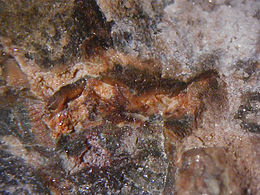|
Ye'elimite
Ye'elimite is the naturally occurring form of anhydrous calcium sulfoaluminate, Ca The mineral is cubic, with 16 formula units per unit cell, and a cell dimension of 1.8392 nm, and is readily detected and quantified in mixtures by powder x-ray diffraction.[5] Occurrence in cementIt is alternatively called "Klein's Compound", after Alexander Klein of the University of California, Berkeley, who experimented with sulfoaluminate cements around 1960, although it was first described in 1957 by Ragozina.[6] Ye'elimite is most commonly encountered as a constituent of sulfoaluminate cements,[7] in which it is manufactured on the million-tonne-per-annum scale. It also occasionally occurs adventitiously in Portland-type cements.[8] It is thus an anhydrous mineral of the cement clinker whose idealized oxide formula 4CaO·3Al2O3·SO3 is also written C4A3S̅ in the cement chemist notation (CCN). On hydration in the presence of calcium and sulfate ions, it forms the insoluble, fibrous mineral ettringite, which provides the strength in sulfoaluminate concretes, monosulfoaluminate, and aluminium hydroxide. It is manufactured by heating the appropriate quantities of finely-ground alumina, calcium carbonate and calcium sulfate to between 1100 and 1300 °C, preferably in the presence of small quantities of fluxing materials, such as Fe2O3. On heating above 1350 °C, ye'elimite begins to decompose to tricalcium aluminate, calcium oxide, sulfur dioxide and oxygen. See also
References
|
||||||||||||||||||||||||||||
